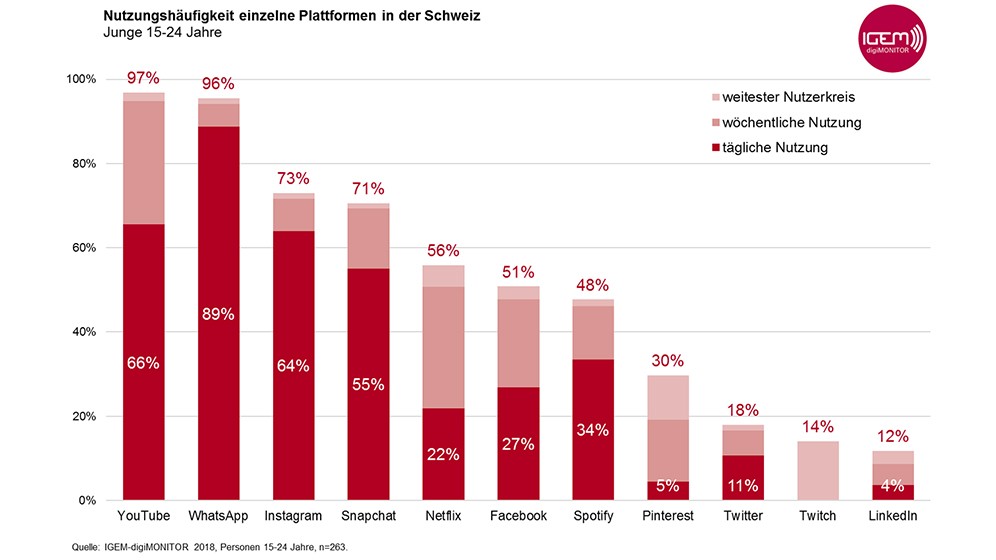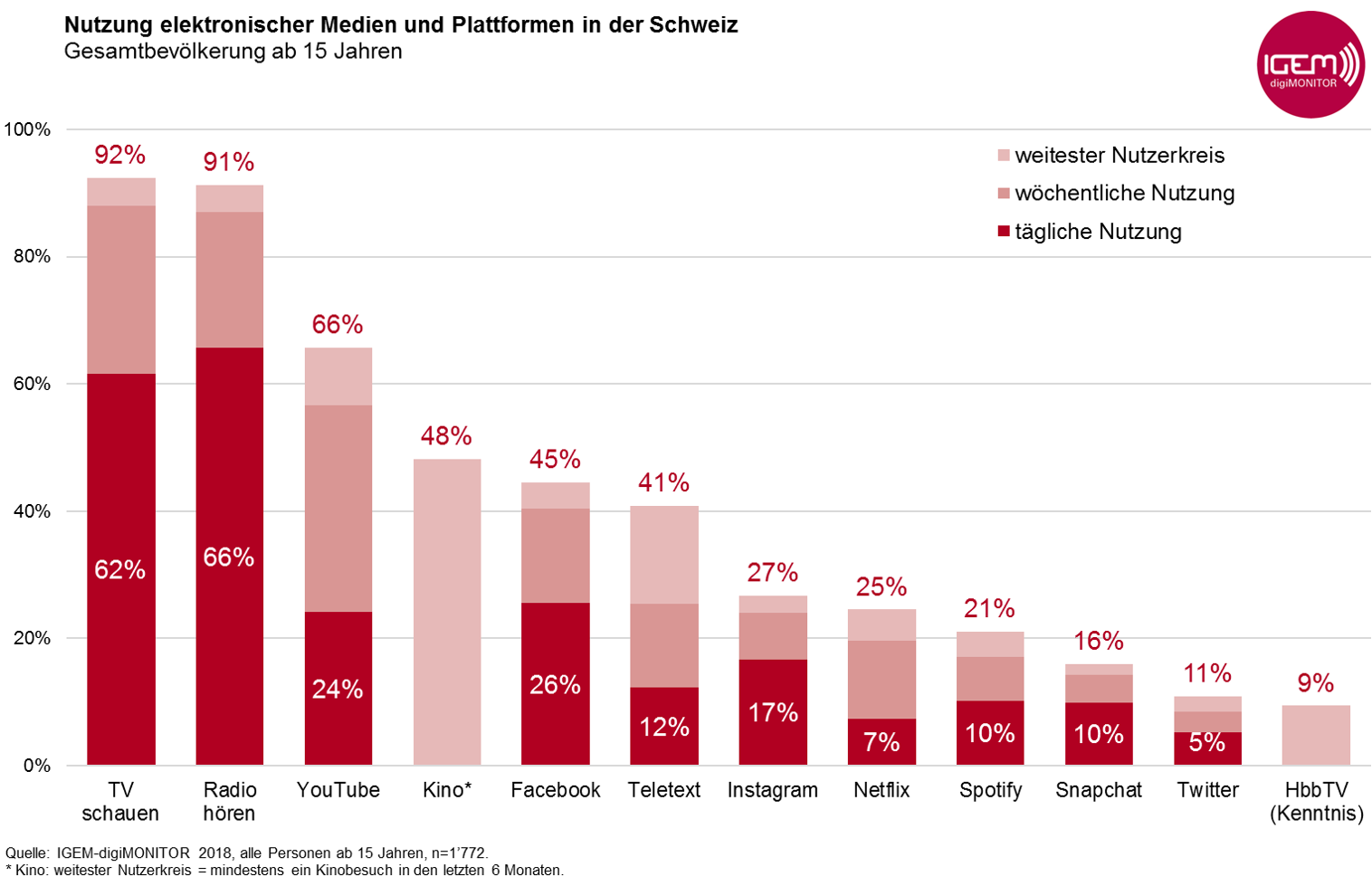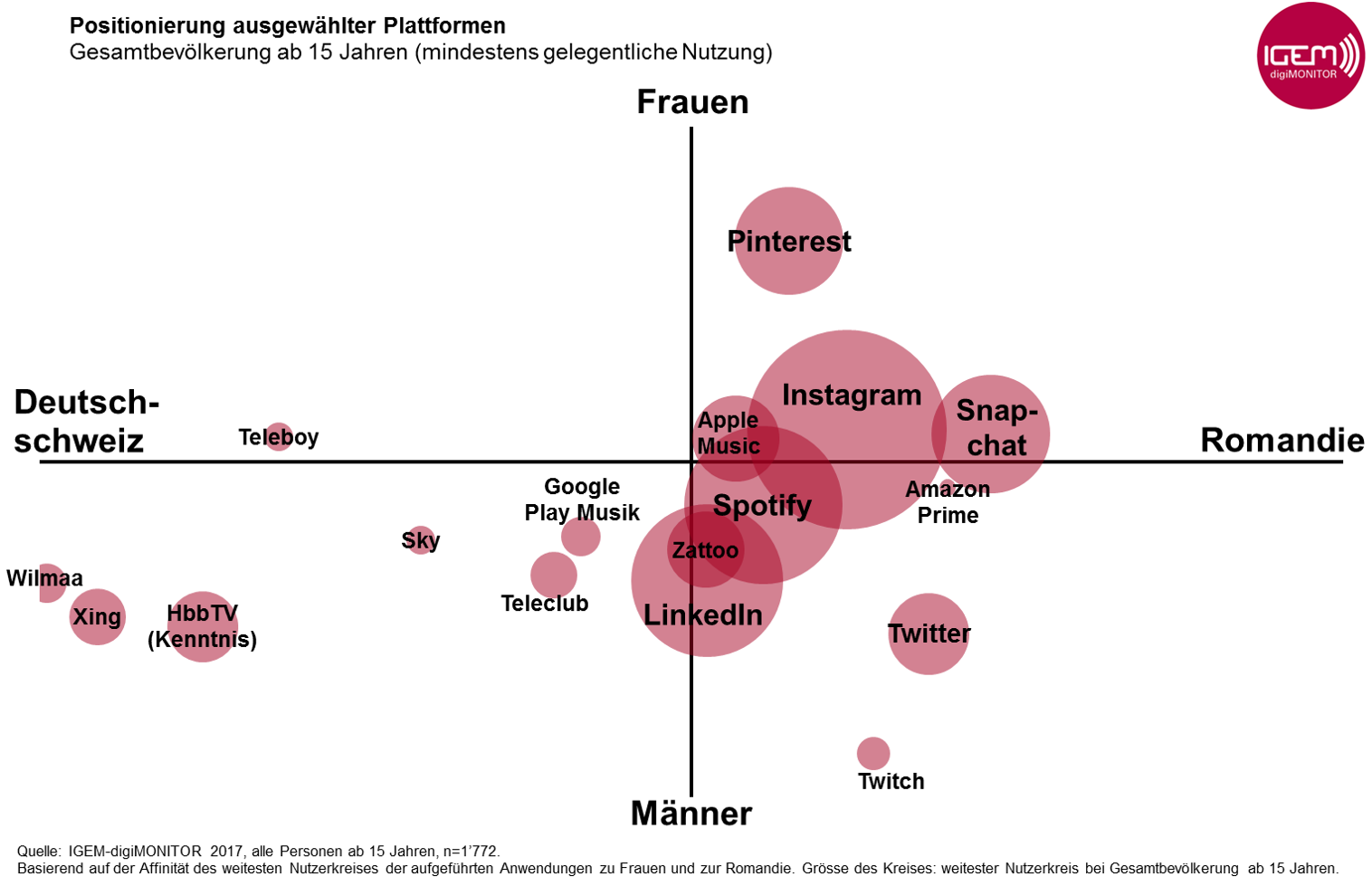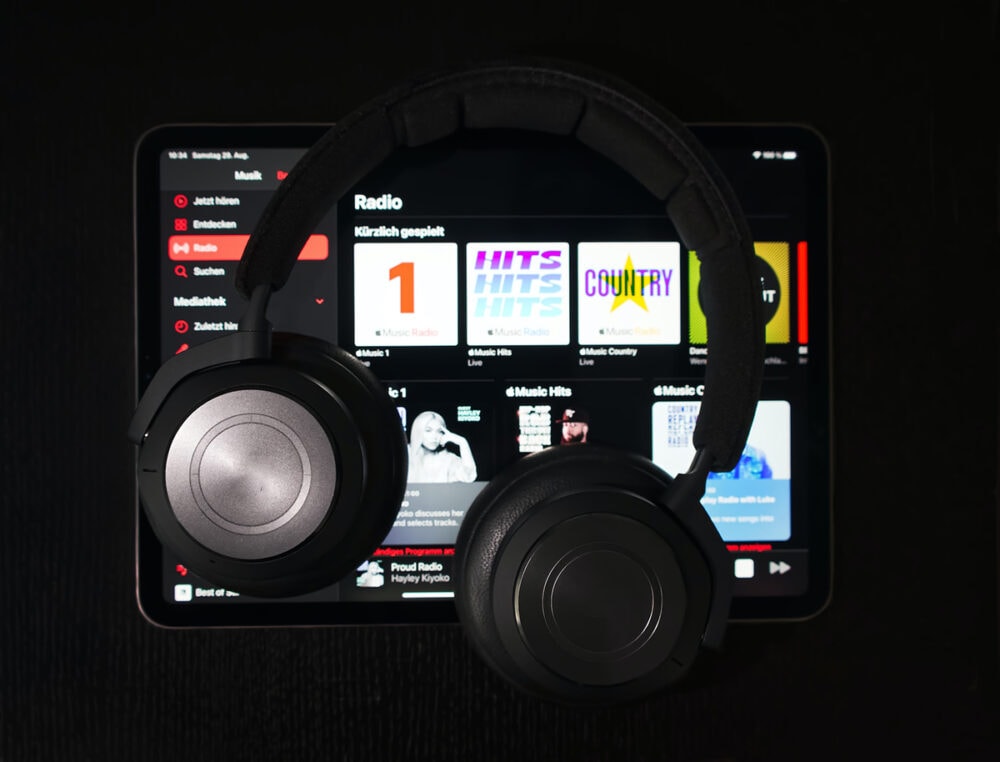Netflix grows by over half a million to 1.5 million viewers in Switzerland
Streaming services such as Netflix, Spotify & Co. are on trend. Netflix is growing significantly and has gained almost 600,000 new users in one year. Netflix now has 1.5 million occasional viewers in Switzerland. 1.3 million people listen to music via Spotify. Surprisingly, TV, radio and cinema remain popular. These are the findings of the "Digimonitor 2018" study conducted by the Interessengemeinschaft elektronische Medien (IGEM) and Wemf.

The key facts at a glance:
- Facebook is losing out among the young: Instagram users are 8 years younger than Facebook users, Snapchat users even 15 years younger
- Women little present on Twitter and LinkedIn: 7 out of 10 Twitter users are men.
- eGames as a male theme: Almost all Twitch users are men. The women are on Pinterest.
- Television, Radio and Cinema remain attractive: Two-thirds of the population watch TV or listen to the radio every day. Half the population and almost 80 percent of the young go to the movies.
- Without Smartphone 98 percent of young people have constant Internet access via their smartphones. Nevertheless, the good old TV set remains the favorite for watching TV - in all age groups.
- Every second man already knows voice-controlled speakers, although the Smart Speaker by Amazon, Google & Co. are not yet officially sold in Switzerland.
- One in four has already had a Virtual Reality Glasses tried out. Only 6 percent wear a Smartwatch.
Streaming services attract young people
Around half of 15- to 24-year-olds watch Netflix at least occasionally or listen to music on Spotify (Figure 5). In the population as a whole, the proportion of Netflix and Spotify users is not even half as large. In total, over 1.5 million people in Switzerland watch Netflix from time to time, which corresponds to a quarter of the total population. (Chart 1) Spotify reaches slightly fewer people than Netflix, but is used more intensively. One-fifth of the population, or 1.3 million people, listen to music via Spotify. The streaming services are equally popular among men and women, as well as in French-speaking and German-speaking Switzerland. Netflix and Spotify users are 34 years old on average.

Four years ago, Facebook reached more than 80 percent of 15- to 24-year-olds; today, it reaches only 50 percent
Instagram and Snapchat leave Facebook far behind among young people. Almost three-quarters of 15- to 24-year-olds use Instagram or Snapchat at least occasionally. Every day, two-thirds of young people in Switzerland are on Instagram and more than half on Snapchat (Figure 5).

Facebook has lost massively in the same age group. (Chart 4) In 2018, only half of 15- to 24-year-olds still use Facebook occasionally, compared with over 80 percent in 2014. 45 percent of the total population are occasional Facebook users. By comparison, over 40 percent of the population uses Teletext to get information. Facebook therefore only reaches around 200,000 more people in Switzerland than teletext. (Graphic 1)

Instagram users are 8 years younger than Facebook users, Snapchat users even 15 years younger
Facebook users are 40 years old on average, 8 years older than the average Instagram user at 32. The age difference with Snapchat is even greater: Snapchat is the youngest platform. An average Snapchat user is not even 25 years old. So more than 15 years of life separate a Snapchat user from a Facebook user.
Two-thirds of the population occasionally watch YouTube. But conventional television still has just under two million more viewers than YouTube in Switzerland. (Graphic 1)
Women less present on Twitter and LinkedIn: 7 out of 10 Twitter users are men
7 out of 10 Twitter users are men. While one in six men aged 15 and over in Switzerland is occasionally on Twitter, only one in 15 women is present there. The career platform LinkedIn shows a similar imbalance: Of the roughly 1.2 million LinkedIn users in Switzerland, more than 800,000 are men and only 450,000 are women.
eGames as a male theme: Almost all Twitch users are men. The women are on Pinterest
Instagram and Snapchat are more popular with women than with men. Both have a 54 percent share of women among their users. But no digital platform is as female as Pinterest. Pinterest has 900,000 users in Switzerland, of which 700,000 are women and only 200,000 are men. This means that 77 percent of Pinterest users are women.
By contrast, eGames are a male domain. The eGames platform Twitch, which belongs to Amazon, is used practically only by men: 85 percent of the almost 300,000 Twitch viewers in Switzerland are men. (Graphic 3)

French-speaking Switzerland is a digital pioneer
There are regional differences in usage. For example, Facebook, Instagram, Snapchat and Twitter are significantly more popular in French-speaking Switzerland than in German-speaking Switzerland. On the other hand, radio is listened to significantly more in German-speaking Switzerland. (Graphic 3)
Young people in Switzerland can't do anything without a smartphone
The most intensively used electronic device in Switzerland remains the smartphone: just under three-quarters of the total population uses an Internet-enabled cell phone every day. Among 15- to 24-year-olds, as many as 98 percent have a smartphone and thus constant Internet access. Even the messaging service WhatsApp can actually only grow among people older than 25. This is because 90 percent of 15- to 24-year-olds already use WhatsApp on a daily basis. Only the TV (88 percent of the total population) and the radio (84 percent) still reach more people overall than the smartphone. (Graphic 2)

Despite smartphone: TV set remains favorite - in all age groups
The classic TV set remains the first choice for watching TV: The Swiss do watch TV shows with all kinds of devices that have a screen, speakers and reception capability. But 84 percent of those who watch TV on multiple devices prefer a classic TV set.
TV, radio and cinema popular with stable usage
Despite the many new digital offerings, TV, radio and cinema remain popular in Switzerland. The use of TV, radio and cinema has also remained surprisingly stable over the last four years. (Figure 1) Two-thirds of people aged 15 and over listen to the radio or watch TV every day. Even among 15- to 24-year-olds, more than one-third watch TV or listen to the radio every day. TV (85 percent) and radio (82 percent) thus still reach significantly more people among the young than Instagram (73 percent), Snapchat (71 percent) or Facebook (51 percent).
Around half of the population goes to the movies. (Fig. 1) Cinema is even more popular with younger people: 4 out of 5 people under 25 go to the cinema at least once every six months, and a large proportion of them several times. Around a quarter of a million more young people are therefore willing to pay for a movie ticket instead of going to Facebook for free.
Every second man already knows smart speakers
Speakers with automatic voice recognition like Amazon Echo or Google Home are not yet officially available in Switzerland. Nevertheless, every second man and every fourth woman already knows what such smart speakers are. (Figure 2) In French-speaking Switzerland (45 percent), smart speakers are much better known than in German-speaking Switzerland (35 percent). However, the devices have so far only functioned to a very limited extent in Switzerland. Therefore, the relatively high level of awareness says nothing about the actual use of smart speakers in Swiss households.
One in four people aged 15 and over has already tried out virtual reality glasses. Wearing a smartwatch is still hardly widespread. Only 6 percent of the total population wear a smartwatch at least occasionally. And 2 out of 3 smartwatches are on a man's wrist. By comparison, in 2018, there are still more people in Switzerland who only have a cell phone without Internet access (14 percent) or no cell phone at all (8 percent) than people who wear a smartwatch (6 percent). (Graph 2)
Little desire for Internet advertising
Internet advertising continues to be rejected by many users: In 2018, a quarter of the total population installed an adblocker on at least one device, which automatically hides advertising. (Figure 2) Among 15- to 24-year-olds, more than a third have such an ad blocker. The number of installed adblockers is rising slightly. For media that finance themselves through Internet advertising, this is increasingly a problem.
About the study
The IGEM Digimonitor was developed by Interessengemeinschaft elektronische Medien (IGEM) together with AG für Werbemedienforschung Wemf. The study has been surveying the use of television, cinema, radio, teletext, video and audio streaming, adblockers and social media via various devices every year since 2014. The data is representative of the entire population in German- and French-speaking Switzerland aged 15 and over, because offliners and people without a fixed network connection are also surveyed. The Lucerne Link Institute collected the current data by telephone from 1772 people, of whom 1013 were in German-speaking Switzerland and 759 in French-speaking Switzerland. The confidence interval is +/- 2.3 percent. The study results are available to IGEM members free of charge and to non-members against payment (5000 Swiss francs).








